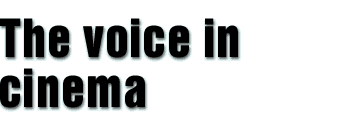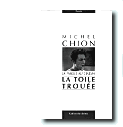|
 |
||
|
Michel Chion, the French composer-filmmaker-critic has devoted his studies to sound in cinema and has become a leader in this area. Soon at the School of Sound in London, he talks to Gill Addison about the voice in cinema |
For those interested in either sound or the voice within film, whether practitioner or student, the work of Michel Chion is a priority on the reading list. Chion has written several books which explore the complexities of the "acoustic" within the cinematic experience. Of his texts translated into English Audio-Vision: Sound on Screen (edited and translated by Claudia Gorbman) and the eagerly awaited The Voice in Cinema (also edited and translated Claudia Gorbman) offer refreshing and intelligent additions to the discussion of sound and specifically the voice.
The Voice in Cinema, is the first part of his influential investigation of sound in the cinema to be translated. A further two books; Le Son au cinema and La Toile trouée remain, as yet, available only in French. Audio-Vision provides a comprehensive overview of the aesthetics and function of sound in film and television. Chion reintroduces and expands upon the concept of the acousmêtre; as discussed and extensively analysed in The Voice in Cinema.
Chion skilfully closes the gap left in many of the discussions surrounding the voice. He carefully delineates and grounds the voice when it is more than "speech" and not reduced to a vehicle for language. His analysis is not limited to a specific genre or to the several films that are routinely exampled when researching the voice and its complexities in relation to film. Nor is The Voice in Cinema academically dry, Chion engages with the films he discusses as experiences and examples of his taste, and not wholly as "texts" which is so often the case. He offers a personal journey through films and the work of filmmakers. He responds creatively and originally, producing acute analysis, that as he suggest in the authors notes can be applied to any number of films that the "Readers may easily find in their own memories". Chion's style of writing is at times poetic and pleasurable, yet this does not detract from the rigor and spectrum of theory he uses to underscore his study. His work becomes as much a source of reference for related texts and concepts, as it is used as a citation within other academic texts.
"The voice is elusive", thus begins the prologue to The Voice in Cinema, which explicitly explore the relationship between image and voice. He introduces and explores the concept of the acousmêtre: the voice whose sources remains absent or separated from the image, and how this particular voice alludes to a panoptic power in and over the films. An all seeing eye, offered to the spectator via the voice. The acousmêtre creates a sense of suspense and insight into the evolving narrative. A voice that resonates "in the air", unfixed to a bodily image. The acousmêtre voice has a lineage that echoes back to the early film of Fritz Lang, specifically The Testament of Dr Mabuse, through to Alfred Hitchock's Psycho and can be used to discuss and analyse the mechanically manipulated voice of technology: Hal for example in Stanley Kubrick's 2001.
Gill Addison: In a recent interview I asked Michel to comment upon the voice within film at present, and if he thought that in relation to the discussions inspired by the "image" in film the voice remains relatively marginalised, and if so why this was the case?
Michel Chion: Within cinema theories the voice has been less marginalised than sound effects. Actually, a lot of books have been published in both French and English on particular questions like the voice-over, but usually always about the same films (American film noir of mid-40s, or films by Bresson and Duras). To date there are not many texts about the voice spoken in dialogues: the way of using the voice, the rhythm, the play with the colour of one's voice, etc. The reasons are obvious: they are the reasons of the language; if you study English cinema, for example, you need to have a sufficient command of not only the English language, but also of the different accents of the different regions in the United Kingdom, and also of different social and professional categories. There are very precise codes and references, which you would miss if you do not know them. The same happen to Italian, French, American cinemas, etc. The sound and the voice are not then the most neglected domain in cinema theory: the art of the actor is the object of very few articles.
Filmmakers, both mainstream and independent, appear to be exploring the complexities and possibilities of the voice "more and more". For example Jane Campion's The Piano, or Derek Jarman's Blue. Do you think this is a response to cinema going audiences being visually more literate than previous generations and the spectacle of the image is no longer as seductive or engaging as it was?...
The original text for The Voice in Cinema was written in 1981, with an epilogue of "cinema's Voices of the 1980s and 90s". Have you seen any recent films in which there is a considered use of the voice, further exploring the relationship between image and voice?...
Would you suggest that the most powerful use of the voice is the acousmêtre. Would you agree that in independent films this is relational to the suggested presence of the author/filmmaker, as in the work of Marguerite Duras?...
Michel Chion will be visiting England in April to take part in the School of Sound. He is a respected composer of Music concrete, director of short films, a critic for Cahiers du Cinéma. He has also published several books on screen writing, Jaques Tati, David Lynch, and Charlie Chaplin as well as sound and the voice.
Thanks to Michel Chion.
Audio-Vision; Sound on Screen and The Voice in Cinema are both published by Columbia University Press, New York.
Full article published in Filmwaves - Issue 10, Winter 2000. Subscribe now!
